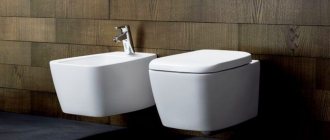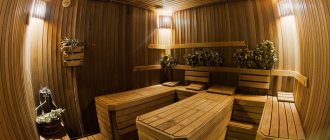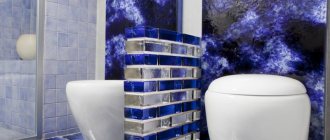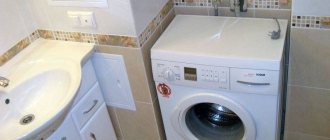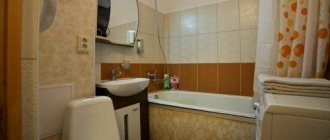Toilet device
Any toilet consists of a bowl and a drain system.
How it works:
- The reservoir contains water for subsequent rinsing of the bowl.
- Activating the flush with a lever raises the flap valve, allowing a predetermined amount of water to flow in through the holes located under the toilet rim.
- The S-shaped bend of the sewer adapter serves two purposes, the main one of which is the direct outflow of liquid from the device. The second is to prevent sewer gases from flowing back into the room.
- When the tank is emptied, the water causes the float to lower, simultaneously pushing the contents of the bowl into the waste pipe.
- After this, the valve again starts drawing clean water to fill the tank to the normal level.
Tank drain device
Water from the supplied pipe flows through a hose into the tank, which in basic models is the tank itself. There are two mechanisms inside: one is responsible for receiving water, the second is for draining.
- The filling system accumulates water to a manually determined or structurally acceptable level.
- The float mechanism (in older models it is made in the form of a bubble or pear) determines whether the water has reached the mark.
- When the water level in the tank exceeds the permissible level (according to GOST - 20 mm below the overflow), the float valve blocks its inflow.
- The flushing system comes into operation when the flush button is pressed. The mechanism is usually combined with transfusion insurance.
- Pressing a button opens the shut-off valve, allowing water to enter the toilet bowl through special drain holes.
Types of toilets
Two types of designs are common: compact and without tank. There are no practical advantages or differences in their use.
Compact The standard or open two-piece type was the only one for a long time. It is a bowl with a drain tank installed on top of it. The system is fixed with bolts and washers, floor installation.
No tank. Hidden type - the flush system is hidden behind the surface of the wall, in niches or furniture. The flush model is sealed, water does not seep into the walls. All components are accessible through a removable panel for the drain button—there is no need to remove the tile for minor structural repairs.
According to GOST 30493–96, the division of toilets into main types looks like this:
- in shape - dish-shaped, visor-shaped and funnel-shaped;
- by type of release - oblique or straight;
- with or without a solid cast shelf.
Additionally, the number of mounting holes is determined:
- in toilets in domestic premises - two or four holes;
- It is allowed to be manufactured without holes for fastening at the request of the consumer.
Types of flush cisterns according to the same GOST:
- installed on the toilet with side or top release;
- low-, mid- and high-mounted type with side launch.
Installation
Based on the installation method, toilets are divided into wall-hung and floor-mounted types.
Floor standing toilet
The toilet is installed in a prepared place: the pedestal is secured with bolts or screws to the floor, depending on the design.
Advantages of the floor system:
- stability and reliability - it is impossible to break the bowl while sitting on it, even for those with serious body weight;
- accessibility of technical components;
- standard - it’s easy to pick up spare parts and accessories even from another manufacturer.
Wall-hung toilet
Features of wall or hanging system:
- free floor under the bowl, which is convenient to clean;
- stylish appearance;
- in most cases equipped with a half flush;
- The toilet must be able to withstand its own weight and the weight of the person sitting on it.
This type is demanding on the frame and fastening system. The installation kit includes a steel frame capable of supporting a weight of several hundred kilograms. But if the structure is installed inside a frame made of profiles, the latter will require additional reinforcement with timber to keep the system in a single plane.
As a result, the sewerage, water supply and drain tank will be hidden inside and behind the frame. After covering the frame, only the bowl itself, protruding from the wall, and a decorative drain button, reminiscent of a switch, will remain on the outside.
Space saving is often mentioned as an advantage of the hanging type. In fact, there is none, because the frame and frame will also require space.
Release
The exhaust system or drain is also divided into types, each of which has its own characteristics.
- vertical - mounted in the fan hole, which is located in the floor;
- horizontal - installation directly into the wall where the fan pipe is located, almost parallel to the floor;
- oblique - placed in a hole in the wall at an angle of 40-45 degrees;
- universal - the socket is distant from the wall of the device, which allows it to be connected to any form of sewer outlet.
Horizontal and universal types are modern. Models with oblique and vertical exits became obsolete back in the 20th century. They cannot be connected to the wrong type of sewer pipe without the use of adapters.
What are toilets made of?
The main materials for the production of toilets are ceramics and steel. Variations made of cast iron, plastic or glass are also available, but their practicality is much lower.
Ceramic - made from sanitary ware or porcelain, so the vast majority of them are white or beige.
- the material is hygienic, it can easily be given a streamlined shape, facilitating convenient cleaning;
- the service life of earthenware products is about 30, and porcelain - up to 50 years;
- do not absorb odor.
Stainless steel - models are usually used in institutions with high traffic. This type is durable and unpretentious in maintenance, but due to its unpresentable appearance and characteristic associations, it is rarely used in residential premises.
Made from cast marble - the material resembles natural one, but has increased strength in comparison with it. Plumbing fixtures made from it are hygienic and have a warm surface.
Made from acrylic - lightweight devices with wall thicknesses up to 6 mm. More often used as guest variations. Durability is comparable to ceramic, but requires special care without chemical solvents and abrasives.
Toilet bowl shape
According to the internal shape of the bowl, toilet bowls are divided into 3 types.
- Visors are the most popular type. The sloping back wall of the bowl ensures a neat flush. The form is the most hygienic.
- Funnel-shaped - the flush hole is located in the center of the bowl. The advantage of this form is that the water drains evenly and instantly. Disadvantage - the flow of increased force contributes to splashing.
- Disc-shaped - inside the bowl there is a kind of platform installed that accumulates waste. The type is outdated and unhygienic.
Additional division according to the appearance of the form:
- Round - this bowl saves space in a small bathroom. The length of toilets of this type is minimal.
- Oval or elongated - the option with the maximum bowl length is considered the most convenient to use.
Water supply
Bottom supply - the hoses are invisible and do not spoil the interior. Connection requires skill, since the joints are hidden under the tank. Bottom wiring requires increased attention to the tightness of connections, as water pressure promotes leaks.
Lateral supply - communications remain visible; the option is not very aesthetically pleasing, but is as convenient as possible during assembly and further maintenance. There are no leaks, except in cases associated with a failure of the float and natural overflow of water.
Genoa bowl or toilet: which is more dangerous to health
The “ancestor” of the modern toilet, on which we sit like a chair, was the first flush device in human history with a cistern, which was invented in 1596 by a man named John Harrington. It cannot be said that this new product immediately gained popularity, so great was the power of habit. At all times, a person relieved his great need, squatting, and, at best, over a hole in the floor - a prototype of the modern Genoa Cup. Until the mid-19th century, the chair-like toilet was only available to the richest and most powerful people, such as members of the royal family.
The earliest toilets appeared in Ancient Egypt. Wealthy Egyptians used toilets with limestone seats. Others sat on what looked like a wooden chair with a hole and a container of sand underneath it. Egypt's hot climate and water shortages hampered the development of sewer systems. Some ancient civilizations in the same era created quite advanced drainage systems: for example, in the Indus Valley more than 2000 BC. e. They were already flushing the toilets with water, but they continued to squat and use the holes in the floor. The Romans built public toilets with stone seats. The houses of wealthy citizens had their own bathrooms with plumbing.
In the Middle Ages, toilets in the form of holes in the ground with wooden seats above them prevailed. In the 12th century, monks began building stone and wooden toilets with gutters leading into the sea or river. Most people in those days used pots. The first public flush toilet was opened in London in 1852. Many rural residents in various countries continued to use latrines and outhouses until the late 1960s.
The tradition of squatting to relieve oneself is considered Asian, since in many of these countries it has been preferred until now. And not at all because of the poverty of the residents, but for reasons of health benefits. Countries such as Japan, Indonesia, India, Bangladesh, Pakistan, China, North Korea, South Korea, Singapore, Sri Lanka, Thailand, Malaysia, Myanmar and Iran continued to use the "Asian style" of defecation long after sit-down toilets became widespread.
And many scientists and doctors consider this position to be more natural for humans. And recent studies confirm its advantages over sitting on the toilet.
In 2015, Israeli researcher Dov Sikirov decided to prove that defecation in a squatting position is significantly more physiological than in a sitting position. The study involved 28 healthy subjects aged 17 to 66 years, who were asked to perform their bowel movements using toilets of different heights (42 cm and 32 cm), including a plastic container in which they were told to squat. Participants then recorded how long it took them to have a bowel movement and how difficult the process was in each position. The results showed that the average time for squatting defecation was 51 seconds, and the average time for the lower and upper toilet seat positions was 114 and 130 seconds, respectively. Further research has also suggested a link between toilet sitting and a range of complications, from heart attacks to hernias and colon cancer.
Another study the same year was conducted by a Japanese team of scientists from the Department of Neurology at Toho University Medical Center and the Department of Urology at Tokyo Medical University. Determined to understand how body position affects bowel movements in humans, the researchers said that squatting is much safer and more comfortable than sitting on the toilet. Six volunteers filled their rectum with a contrast solution and were then instructed to release the liquid in different body positions. The researchers found that squatting increased the width of the anorectal angle, which resulted in less abdominal tension in the participants.
A separate study by Pakistani researchers found that those who squat to defecate experienced significantly less symptoms of chronic anal fissures. 100 patients with signs and symptoms of chronic anal inflammation were examined. Researchers' conclusion: Changing bowel habits using a Genoa cup results in complete rectal emptying in a shorter time and with less force required. This leads to a reduction in symptoms and cure of a chronic anal lesion.
Functions of toilets
The basic functionality of the toilets is the same, and additional functionality is determined by the presence or possibility of installing accessories.
Half flush
The design of the drain mechanism contains an additional valve responsible for partial emptying of the tank. Models with such a drain come complete with a double button, which allows the standard emptying of the entire tank when fully clamped.
Some types provide for volume adjustment, but in most cases the valve is automatically installed at the height of the middle of the tank. When you press one button, the volume specified by the additional valve is drained.
Water savings when using this function reach a third of the monthly norm consumed by the toilet.
Automatic drain
The drainage system is activated by a motion sensor installed in the bathroom. As soon as a presence is detected, water begins to fill the tank. The drain turns on automatically when a person leaves the room.
The system has a number of features :
- Those who like to sit in the toilet with books will need to move their hands from time to time so that the sensor detects the presence.
- The system reacts to pets. If the cat is toilet trained, the automation will relieve owners from having to control the cleanliness of the equipment after the pet visits the toilet.
Hygienic shower
An accessory that turns the toilet into something like a bidet. Some models come immediately complete with a shower built into the lid or sidewall. If such functionality is not provided, the accessory can be installed as a separate element on the wall next to the device.
The device is used not only for its intended purpose, but also for conveniently collecting water in tall containers, as well as for caring for animal trays.
Seat microlift
A kind of closer that allows smooth lowering and raising of the lid. The microlift mechanism is a rod for rigidly fastening the lid and a spring that slows down its rotation.
Peculiarities:
- The seat with this accessory closes silently.
- The lid cannot be lowered faster than the mechanism allows. If you apply force, the mechanism will break.
The accessory is not tied to the type of toilet. It is enough to install a seat that supports this option.
Auto raise/lower seat
Mention of this function in most cases means talking about a microlift. But there is also a rare specialized accessory. This is a mechanism with a pedal and a drive that powers the seat - like on Soviet garbage cans.
Advantages:
- hygiene - you don’t have to touch the seat with your hands;
- ease of installation without reference to models;
- convenience for people with disabilities.
Most often used in public places: airports, hotels.
Heated seat
The accessory is suitable for all types of devices; the heating element is built directly into the lid.
- in advanced models, heating is regulated by a sensor, different temperature modes and safety control are available;
- often combined with other rare functions - a massager, a pulse meter, self-cleaning retractable nozzles.
Comes complete with ergonomic seats for increased comfort. More often with a control panel - separate or built-in on the side.
Air drying
This function is often combined with a built-in hygienic shower. Found in luxury models. There are two types:
- After using the built-in shower for hygiene procedures, the warm air supplied by the toilet serves as a replacement for toilet paper. In the West, such models are positioned as equipment for people with disabilities, pregnant women and those undergoing a rehabilitation period after abdominal surgery.
- The second type does not require a shower and partially replaces heating systems.
Antibacterial coating of toilet bowls
The protection allows you to keep the lid and inner surface clean. Variations of plating based on silver or zirconium are available. Most often in combination with ultraviolet antibacterial lighting.
Two main types:
- Protection does not change the appearance of plumbing. Models equipped with it feel a little rougher than usual. This type of coating is intended for ceramic models only and is applied before production firing.
- Another type is with external coating of antibacterial metals.
Any of the above coatings prevents bacteria and mold.
What is the "Genoa Cup"?
There are several versions of the name, but the most plausible is the following: the prototype of the modern Genoa bowls was first installed in a public restroom in the Italian city of Genoa, where the name came from. Another name, “Turkish toilet,” is associated with the wide distribution of this type of plumbing in the east and central Asia.
As for the scope of application, the Genoa bowl can rarely be found in a private house or apartment. This is due to the lack of comfort during use: to use a toilet of this design, you need to sit down and remain in this position for quite a long time, which is very tiring and uncomfortable.
However, these disadvantages quickly turn into advantages when it comes to public toilets, medical, children's, administrative and other institutions where a large number of people use one bathroom.
This is explained quite simply: when using a Turkish toilet, there is no need for a seat, which, without exaggeration, can be considered an item of personal hygiene. In addition, installing a “Genoa” bowl in public toilets almost completely eliminates the possibility of acts of vandalism and mechanical damage to plumbing. Thanks to these properties, built-in toilets are installed in:
pros
The advantages of toilets depend on the method of their installation, water supply and sewerage. The last two parameters determine the need for additional pipes, fittings and adapters. Sometimes in rooms with complex geometry, a set of adapters and extensions is comparable in cost to the cost of the toilet itself.
More joints mean more weak points that are susceptible to breakage and leaks. Therefore, the advantage remains with options that require a minimum set of fittings.
With tank:
- quick access to communications docking points for maintenance;
- installation does not require renovation of the premises or installation of frames;
- stability regardless of the weight of the person sitting, the plumbing is reliable;
Without tank floor:
- free from the disadvantages of compact systems, aesthetically pleasing;
- unpretentious in maintenance.
Without tank suspended:
- unsightly details are hidden from prying eyes;
- technological niches and frames often do not eat up the entire space - functional cabinets or shelves are created on their basis;
- open floor - easy to clean, no debris accumulates.
Manufacturers
We present a short overview of the most popular brands of floor-standing toilets on the Russian market.
Roca
This Spanish international company began its activities in 1929. Since 2004, a subsidiary of the Roca Group has been successfully operating in Russia.
Advantages of floor-standing toilets:
- Environmental friendliness;
- There is an anti-splash system;
- Wide range of models;
- Prices from 2,000 to 500,000 rubles.
Flaws:
- Problems with the seat mechanism;
- Noisy water drainage;
- Poor rinsing.
Vitra
The largest plumbing concern in Turkey produces a variety of products for bathrooms and toilets, which are in wide consumer demand.
Advantages:
- Functionality;
- High-quality fittings;
- Optimal forms;
- Economical drainage system;
- Large selection of models;
- Budget options;
- Cost 2000-30000 rubles.
Flaws:
- Weak drainage system.
Jika
A popular Czech brand in many countries around the world. Their first plant for the production of toilets and other sanitary ware was founded in 1878.
Pros:
- Reliability;
- Ease of use;
- Compact dimensions;
- A large assortment;
- Affordable prices: 1000-12000 rubles.
Minuses:
- Lack of seating;
- Expensive repairs.
Cersanit
Polish leader in the production of sanitary equipment. They specialize in comprehensive products for bathrooms and powder rooms.
Advantages of Cersanit toilets:
- Quality materials;
- Easy to maintain;
- Reliability;
- Price range 1500-10000 rubles.
Flaws:
- There is no anti-splash;
- Weak flush system.
Gustavsberg
Swedish floor-standing toilets of this brand have been produced since 1939. The materials used are both porcelain and earthenware.
Their advantages:
- Ergonomics;
- Ease of maintenance;
- Silent operation of the cistern;
- High-quality fittings;
- Long-term warranty (25 years);
- Excellent drainage system;
- Cost from 3,000 to 20,000 rubles.
Related article: What dry building mixtures exist for plastering work?
Flaws:
- There are fakes;
- Not sold everywhere;
- Not all service centers are serviced.
Sanita
Russian stamp from the city of Samara. The production has been operating since 1944. The first Soviet plant where porcelain casting technology began to be used and nothing else is used besides it.
Advantages of floor-standing toilets of this brand:
- High quality porcelain;
- High-quality fittings;
- Excellent flush system;
- Reasonable prices: 2000 – 8000 rubles;
- Classic design;
- Self-cleaning coating on some devices.
Flaws:
- Lack of anti-splash system;
- Unreliable seating mechanism.
Problems
Inconveniences depend on the type of product.
Toilets with tank
- systems of this type are always floor-mounted;
- the space required for the tank is in most cases non-functional;
- inconvenience when cleaning the floor; dust and debris accumulate behind the pedestal, which are difficult to reach.
- unaesthetic - communications in plain sight.
The length of models with a solid cast shelf is at least 605 mm; compact models from 330 mm are inconvenient in everyday life. Combined with the size of the tank, which even in smaller models usually extends beyond the dimensions of the device, the toilet will require at least half a meter of free space.
Without tank
Hanging:
- access to communications is difficult - an inspection hatch is required for major work, the rest is carried out through the hole for the button.
- a steel frame cannot be hidden in a closet - it will require covering with plasterboard or panels, and with it additional costs for finishing materials.
Floor:
- installation requires a niche or frame that masks the drainage system;
- combine the inconvenience of servicing wall-mounted and floor-standing models.
All tankless systems share a common problem - costly installation.
The frame width in hanging models reaches 50 cm. Smaller variations of 35 and 40 cm are less reliable in operation and can withstand less weight. The frame is attached to the floor and base walls of the bathroom.
Strengthening the sheathing frame is often required. It is inappropriate to leave the structure in its original form - it must be protected from moisture and decorated. Labor costs for installation are comparable to a complete renovation of the premises.
Further maintenance of the suspension system in case of breakdowns and leaks requires access through the button cover. The hole is small - it is difficult to work with two hands. Accordingly, tightening and sealing fittings, not to mention replacing parts, will take several times more time than when working with a conventional cistern toilet.
To simplify access, it is customary to leave an inspection hatch in an inconspicuous place behind the toilet. This will speed up access to communications and facilitate maintenance.
Hatches are supplemented with special doors (usually ready-made plastic ones) of the required size. Comfortable for work - the width of two standard wall tiles 15 by 20 cm. As a result, the width of the hatch will be just under 30 cm, taking into account the sides and frame.
How to choose a toilet
When choosing, you should pay attention to a number of parameters.
Dimensions – Make sure your new toilet fits the space. To do this you need to measure the distances:
- From the wall behind the planned installation location to the maximum point to which the toilet can extend without causing movement problems. Relevant for small bathrooms.
- From the center of the nearest sewer pipe to the point where the device will be connected. You need to take measurements with a reserve for pipe joints - they are individual and depend on the material.
- The third size is from the cold water supply pipe to the installation site. It is optimal to take two measurements at once - one taking into account the side liner, the second for the bottom option. The dimensions will help determine the need for extension of flexible hoses.
Shape and height - there are models with increased or decreased height of the pedestal for comfortable use, depending on the height and length of the legs. The depth of the device often depends on its shape. Extended variations of plumbing fixtures are more convenient in everyday life, but more demanding on space.
Cleaning - decide what kind of flush system should be: anti-splash, straight or circular. The last option comes with the ability to quickly clean the device.
This also includes the need for an antibacterial coating or free space under the toilet to make cleaning the floor easier.
Insulated tank - the possibility of its installation is determined by the space parameters. It will not be possible to do without partial renovation of the bathroom. But aesthetics and comfort often justify the cost of reorganization.
Fasteners and drain system - when choosing a device, check the completeness, make sure the float and plastic fittings are intact. In suspended models, you need to pay attention to the seams and joints of the frame - there should be no tears, peeling paint or signs of corrosion.
Make sure that the fasteners fit freely into their sockets and are the right size. The mounting surface (the junction with the wall in suspended models, and with the floor in others) must be flat, without drops or notches.
With bidet
When there is little space in the bathroom, but you want to equip it with everything you need, you can install a shower toilet . The device has so many functions and capabilities - except that it doesn't fly. But its price is much higher than a regular toilet, but the expense is justified. As soon as the user occupies the seat, the built-in air purification system is automatically activated. The bidet function is activated by simply pressing the remote control button. The shower is mounted directly under the toilet seat and pulls out when needed. The water is supplied already heated to body temperature (the degrees can be adjusted manually), and the stream can be pendulum, pulsating massage or “lady’s”, adapted to the characteristics of the female body. Then the hair dryer is put into operation, which supplies warm drying air. But that’s not all, the higher the price of the equipment, the more functions it offers.
As an alternative and as a cheaper bidet option, you can purchase only a bidet lid , which can be of various modifications. Outwardly, it looks like a regular lid, but in the thickening of the rim there is a pipe that supplies water. These devices are universal and fit almost any toilet model.
Article on the topic: 3D photo wallpaper for walls: for children's, black and white, renovation for the bedroom, combining rooms, flowers, is it possible to glue with roses in the interior, video
Which is better
The best type of toilet varies from person to person:
- The device should be easy to care for and maintain, harmonize with other equipment and fit into the dimensions of the room without creating inconvenience.
- Ideally, water and sewerage connections should not require the purchase of additional pipes and fittings. In this case, to install the toilet you will only need to fasten and connect the necessary communications.
- Availability of service centers and warranty service points during the first year of operation is a priority.
- Spare parts for devices from little-known manufacturers will be difficult to find if the toilet is different from the standard one.
Genoa bowl toilet – affordable price!
When purchasing a Turkish toilet, as a rule, you also buy related products, namely: a tank, a siphon, a mixer, an installation, a flush tap, etc. Many online stores offer to buy a Genoa bowl toilet and accessories for it (see the article “Where is the best place to buy toilet fittings"). For example, a floor-standing toilet can be purchased on the website (https://www.trubmarket.ru/santekhnika/sanfayans/chasha-genuya-i-komplektuyushchie/). In this online store you can purchase a Genoa bowl toilet, the price of which is very low, regardless of whether you buy wholesale or retail.
How to use
The first step after installing any type of plumbing fixture is to prevent water from getting into unintended areas. All joints with surfaces must be treated with sanitary silicone sealant. It will need to be updated from time to time.
How to understand that the sealant needs to be replaced:
- The silicone layer has turned yellow or gray - renovation for aesthetic purposes.
- The sealant looks normal, but allows water to pass through - complete removal is unnecessary, a spot update is enough.
- The silicone is covered with a black coating - there are problems with ventilation in the room. Plaque is a fungus. If you do not plan to change the hood and install an additional fan, the sealant will have to be renewed every six months.
Further maintenance of the toilet boils down to its hygienic cleaning.
Regardless of the type of device and the material from which it is made, it is unacceptable to clean the equipment with sharp metal objects.
- Glazed surfaces are cleaned with any available means, including solvents and alkalis. The surface will not be damaged.
- Acrylic models cannot be cleaned with chemical solvents.
- The resulting plaque is removed with special means. Household mixtures are also used - soda with lemon juice, water and vinegar in equal proportions.
- Upon completion of washing and cleaning, wipe the device with a dry, soft, lint-free cloth.
Equipment should be protected from falls and impacts. All models, except those made of stainless steel, can be broken. The stainless steel version will not crack, but may become deformed.
Guarantee
Manufacturers' warranties do not cover mechanical damage to the toilet or tank. The use of unsuitable cleaning agents, incorrect installation or operation is also not covered by the warranty.
Manufacturers carry out repairs or replacements only if there are manufacturing defects and defects, so multi-year warranty periods are not an advantage; a minimum of 1 year is sufficient. If the device contains manufacturing defects, they will be identified during this period.
Most manufacturers provide a standard warranty on plumbing fixtures of 3-5 years.
Why is it called a genoa bowl, tips for choosing and installing a floor-standing toilet
Among the variety of toilets used in private and public toilets, one can especially highlight the type called the “Genoa bowl”. The scope of application of such toilets is determined, first of all, by their design features. The lack of comfort is fully compensated by mechanical strength and high anti-vandal properties.
This review discusses the main types, features of installation and operation of the Genoa bowl, and also identifies the most likely area of application. The advantages and disadvantages of built-in floor-standing toilets will be analyzed separately.
Malfunctions and repairs
More often the filling of the drain tank breaks. Most problems can be fixed on your own.
Water continues to flow after releasing the drain button
To determine the source of the problem, you will need to remove the cover from the device and observe the operation of the system.
- Wait until the tank is filled with water.
- If the liquid continues to decrease during filling, this indicates that the damper is not operating correctly.
- Check the shut-off valve for tightness, integrity and absence of signs of corrosion or limescale deposits.
If deposits are found, it is enough to clean them with a suitable product. In case of depressurization, sanitary silicone is used - for this, the tank will have to be emptied and dried. If the valve is bent or the hole is widened due to hard water, the valve ring will need to be replaced.
Tank leak
This problem is evidenced by the influx of water from places not intended by the design. There may be several reasons:
- Wear of the rubber gasket between the tank and the toilet occurs more often due to the instability of the tank and the weakness of the fasteners. There are wear options due to poor-quality old rubber, limescale or mechanical damage. The verdict in all these cases is the same - the gasket must be replaced. You can purchase an analogue at any plumbing store. Installation will require twisting the tank and sealing the connections.
- The washers of the bolts that secure the tank to the device were worn out - the tank will need to be dismantled. Further inspection of the washers will tell you whether they need to be completely replaced or whether the sealant needs to be updated. It is important not to overtighten the bolts during installation.
- Incorrect operation of the float - due to hard water, the bottom of the float becomes covered with limescale. Its falling off during the flushing process can deform the float or cause uncontrolled overflow. If the integrity of the device is beyond doubt, there are no signs of deformation, it is enough to clean the bottom of deposits. In other cases, you will have to change the float, and in rare models, the entire drain mechanism.
- Crack in tank - Buy a porcelain repair kit or make your own by grinding a small piece of porcelain into powder and mixing with epoxy glue. At the time of repair, the tank must be emptied and dried. Fix the crack by applying the mixture with a putty knife. Leave it for a day to dry and then carefully fill the tank with water. If the leak is fixed, it will last for several more years with a patch. In difficult cases, the tank must be replaced.
Difficulty flushing
The problem is due to the low water level in the tank or the valve flap closing too quickly.
- Lift the reservoir cap to check the water level. It is set by a float - a rubber or plastic ball floating on the surface. If the level is low, adjust it manually to fill the tank to the desired volume.
- If there is a problem with the valve, check the length of the chain attached to it. Adjust the tension without over-tightening the chain.
Water does not drain
The sewer pipe is clogged.
Cleaning methods:
- A tool for removing blockages - will help in mild cases or when clogged with household waste and grease.
- Plunger - creates a vacuum that pushes individual particles of clog to the surface.
- Mechanical cleaning - in difficult cases. Depending on the depth of the problem area, you will need a long knitting needle, a piece of flexible hose or a special cable. To be effective, pulling and pushing is combined with filling the hole with degreasers.
If none of the solutions work, call a plumber.
The button doesn't work
Traction is damaged. You will need to remove the cover, disconnect the button and check the nature of the damage. If the part is metal, in most cases it will be deformed, but intact. It is straightened using improvised means, after which the push-button system is assembled in the reverse order.
In the case of plastic button fittings, we can talk about tearing or breaking off the legs of the part. Will need replacement. As a temporary solution, the broken rod is replaced with a piece of thick wire or a long thin sliver.
To troubleshoot the drain system, the shut-off valve is closed and the mechanism is disconnected from the water supply network to avoid spills.
